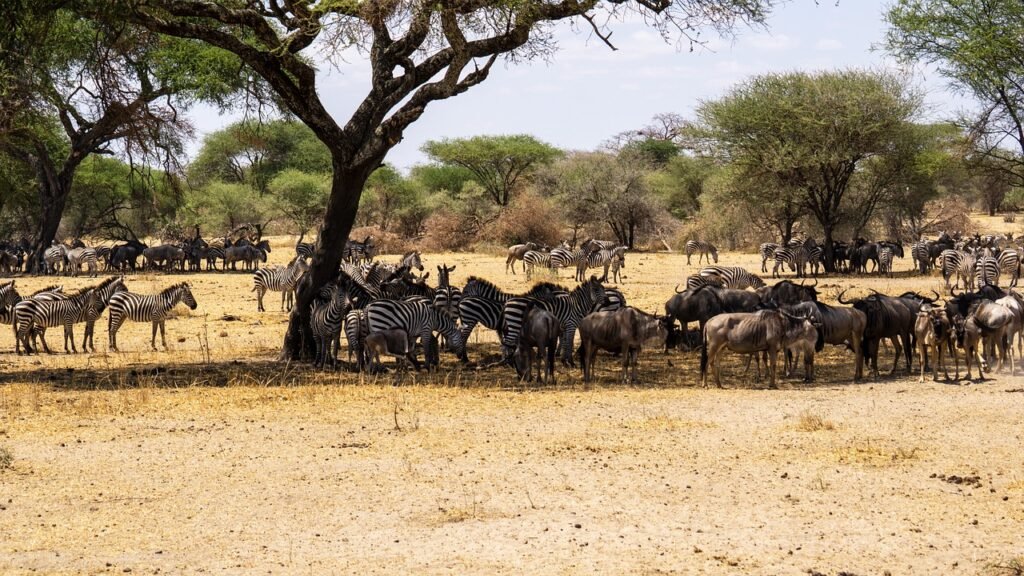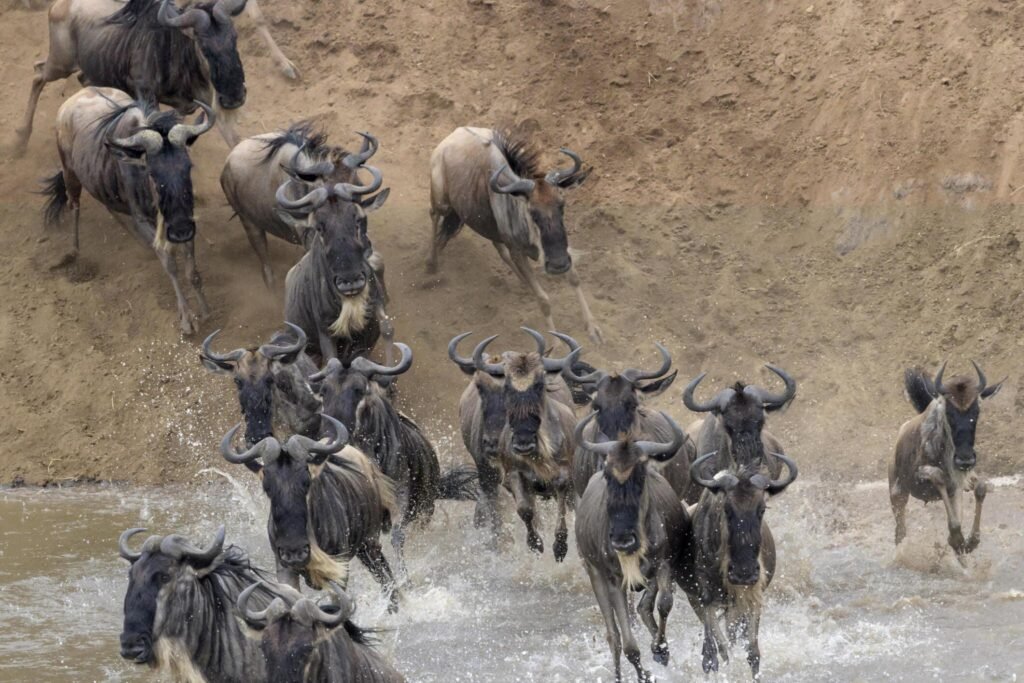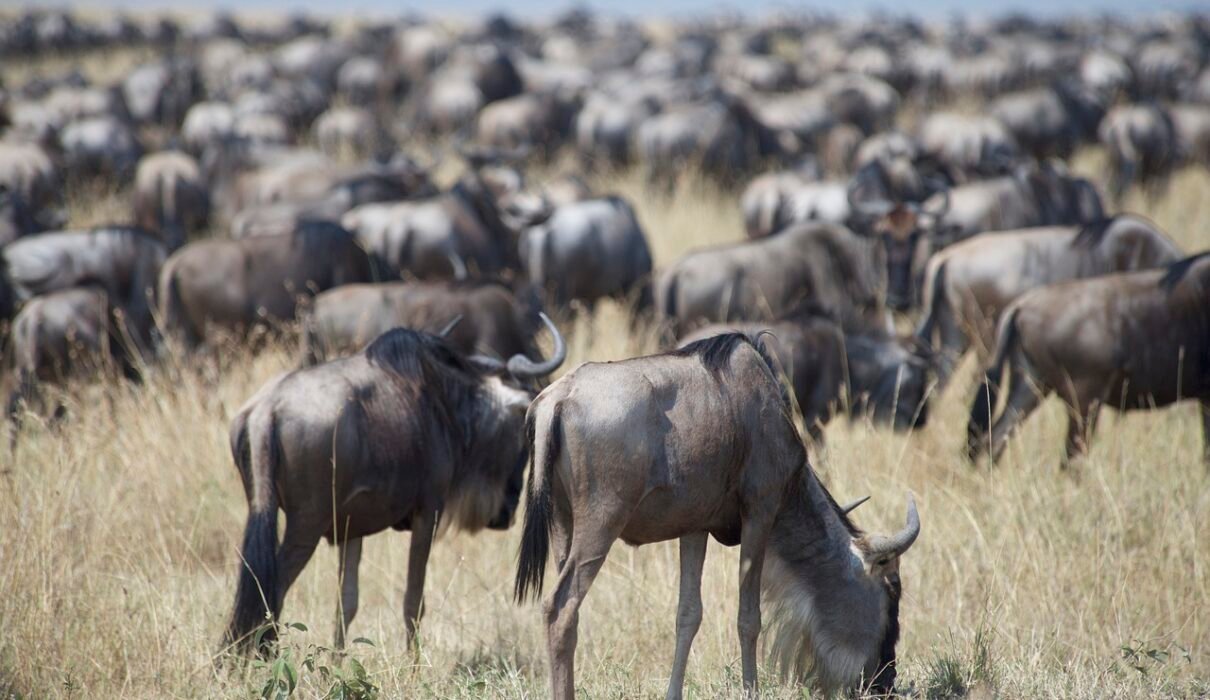Interesting Facts About Wildebeest Migration : The wildebeest migration is one of the most incredible natural events on Earth. Every year, over 1.5 million wildebeests, along with thousands of zebras and gazelles, travel in a circular migration across the plains of the Serengeti in Tanzania and the Maasai Mara in Kenya. This epic journey, often called the Great Migration, is driven by the search for fresh grazing lands and water. The migration is not only a visual spectacle but also a dramatic survival story as these animals face numerous challenges along the way.
In this article, we’ll uncover fascinating facts about the wildebeest migration, highlighting key stages, behaviors, and survival strategies of the animals involved.
Plan your visit to witness the Great Migration here.

Interesting Facts About Wildebeest Migration ; The Migration Is a Continuous Journey
The wildebeest migration is not a one-time event but a year-round cycle that never stops. The herds move in search of fresh pastures and water, covering a distance of around 800 kilometers (500 miles) annually. While the migration has specific peak moments—like the river crossings and the calving season—it’s a continuous movement that follows the seasonal rains.
- Distance Covered: Approximately 800 km annually.
- Timing: Driven by rainfall patterns that dictate grass growth.
Read more about how weather influences the migration.
Interesting Facts About Wildebeest Migration : The Great Migration Includes Over 1.5 Million Wildebeests
The wildebeest are the main stars of the Great Migration, but they aren’t alone. Over 1.5 million wildebeests, joined by around 300,000 zebras and 200,000 gazelles, take part in this incredible journey. The large numbers make it one of the largest land migrations in the world.
- Number of Wildebeests: Over 1.5 million.
- Other Species: Zebras, gazelles, and elands also join the journey.
Discover more about the animals of the Great Migration here.
Interesting Facts About Wildebeest Migration : Calving Season Brings Over 500,000 Newborns
One of the most exciting times in the migration cycle is the calving season, which takes place between January and March in the southern Serengeti. During this period, over 500,000 wildebeest calves are born in just a few weeks. This baby boom attracts predators like lions, cheetahs, and hyenas, leading to dramatic predator-prey interactions.
- Calves Born: Over 500,000 calves in a few weeks.
- Predator Action: Increased predator activity as they hunt the vulnerable newborns.
Learn more about wildebeest calving season here.
Interesting Facts About Wildebeest Migration : River Crossings Are the Most Dangerous Part
The river crossings at the Mara and Grumeti Rivers are perhaps the most well-known and dramatic parts of the migration. Here, the herds must brave strong currents and dodge waiting predators like crocodiles, making it one of the deadliest parts of their journey. Many wildebeests don’t survive the crossings, but those that do continue their journey north.
- Key Rivers: Mara River and Grumeti River.
- Dangers: Drowning, crocodile attacks, and stampedes.
Read more about the dramatic river crossings here.
Interesting Facts About Wildebeest Migration : Zebras and Wildebeests Have a Symbiotic Relationship
During the migration, wildebeests and zebras often travel together. These two species complement each other: zebras feed on the taller grass, leaving the shorter, more nutritious grasses for wildebeests. This symbiotic relationship helps both species survive and thrive during their long journey.
- Zebra’s Role: Eats the tall grass.
- Wildebeest’s Role: Follows behind, eating the shorter grass.
Learn more about the relationship between wildebeests and zebras.
Timing Is Key to Witnessing the Migration
While the migration is a year-round event, certain times of the year offer better chances to witness specific parts of the journey. The best time to see the famous river crossings is from July to October when the herds cross the Mara River. The calving season is best seen in the southern Serengeti from January to March.
- Best Time for River Crossings: July to October.
- Best Time for Calving Season: January to March.
Explore the best times to see the migration in detail.
The Great Migration Is Vital for the Ecosystem
The wildebeest migration plays a crucial role in maintaining the ecosystem of the Serengeti and Maasai Mara. As the herds graze across the plains, they help trim grasses, which encourages new growth. This grazing cycle promotes biodiversity by maintaining the health of the savannah and supporting various other species that depend on these habitats.
- Ecosystem Impact: Grazing supports plant growth and biodiversity.
- Biodiversity: Wildebeest migration maintains the balance of life in the Serengeti.
Learn more about the ecological significance of the Great Migration.
Predators Follow the Migration
Where there is prey, predators follow. The migration attracts some of Africa’s most famous predators, including lions, leopards, cheetahs, and hyenas. These predators rely heavily on the migration for food, especially during the calving season and river crossings.
- Top Predators: Lions, cheetahs, leopards, and hyenas.
- Survival Strategy: Wildebeests rely on their numbers to confuse predators and reduce individual risk.
Find out more about predator-prey dynamics during the migration.
The Migration Is a Global Phenomenon
While the migration primarily takes place in Tanzania’s Serengeti and Kenya’s Maasai Mara, it has captured the attention of the entire world. Every year, thousands of tourists travel from across the globe to witness the migration firsthand, making it one of the most famous wildlife events on Earth.
- Global Attraction: Draws tourists, filmmakers, and wildlife enthusiasts.
- Economic Impact: Tourism driven by the migration supports local economies.
Read more about the global appeal of the Great Migration.

Interesting Facts About Wildebeest Migration : Conservation Efforts Are Crucial
As the migration faces challenges from climate change, human encroachment, and poaching, conservation efforts are becoming increasingly important. Many organizations are working to protect the migration routes and the animals involved, ensuring that this natural wonder continues for future generations.
- Threats: Habitat loss, poaching, and climate change.
- Conservation Efforts: Focus on protecting migratory routes and reducing human-wildlife conflicts.
Support conservation efforts for the Great Migration.
Interesting Facts About Wildebeest Migration : Conclusion
Interesting Facts About Wildebeest Migration : The wildebeest migration is one of nature’s most fascinating and dramatic events. From the massive herds crossing dangerous rivers to the intense predator-prey interactions, every part of the migration is a testament to the survival instincts of these incredible animals. Whether you’re interested in seeing the calving season or witnessing the iconic Mara River crossings, the Great Migration offers unforgettable wildlife experiences.
To witness this once-in-a-lifetime event, explore your travel options with Kilimanjaro Climb Specialist or Eddy Tours & Safaris.

